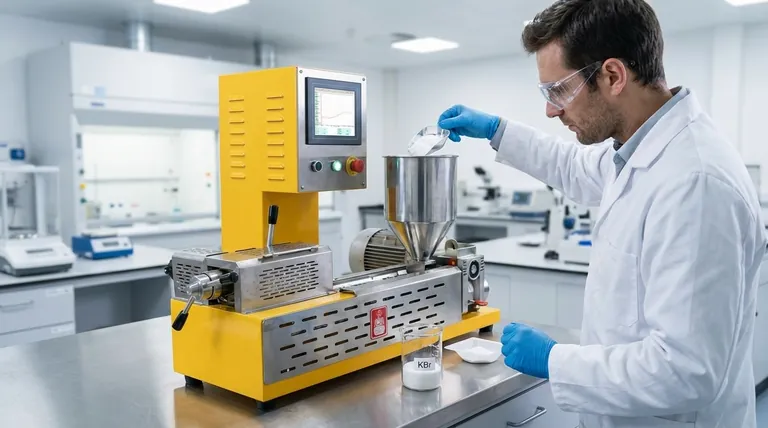In short, yes, potassium bromide (KBr) is considered hazardous, but its risk level is generally low with proper handling. While not acutely toxic in the way many other lab chemicals are, it is a known irritant and can cause significant health effects with prolonged or high-dose exposure. The primary hazards are skin and eye irritation, respiratory tract irritation from dust inhalation, and potential neurological effects if ingested.
The core principle for handling KBr is to treat it with standard laboratory diligence. While the procedural precautions for its use in spectroscopy focus on sample purity, the safety precautions focus on preventing direct contact and inhalation by using basic Personal Protective Equipment (PPE).

Understanding the Primary Health Risks of KBr
The hazards associated with potassium bromide are well-documented and primarily relate to irritation and the systemic effects of bromide ions on the nervous system.
Skin and Eye Irritation
Direct contact with KBr powder can cause irritation to the skin and eyes. This is a common characteristic of many salt compounds and is a primary reason for wearing gloves and safety glasses.
Inhalation of Dust
When KBr is in a fine powder form, as is common for creating spectroscopic pellets, its dust can be inhaled. This can lead to irritation of the nose, throat, and respiratory tract.
Ingestion and Systemic Effects
The most significant health risk comes from ingestion. The body absorbs the bromide ion, which can accumulate and interfere with nervous system function, a condition known as bromism.
Symptoms of bromism can include drowsiness, depression, memory loss, confusion, and in severe cases, psychosis or tremors. However, this typically requires chronic exposure or ingestion of a large single dose.
Contextualizing the Hazard Level
It is crucial to distinguish between acute toxicity and other health hazards. KBr has a low acute toxicity, meaning a single, small, accidental exposure is unlikely to cause severe harm.
Low Acute Toxicity
The risk from KBr is not immediate poisoning. Its hazard profile is more comparable to other common laboratory salts that require careful handling rather than extreme containment measures.
Chronic Exposure is the Main Concern
The risk of developing bromism is primarily a concern for those with repeated, long-term exposure without proper safety measures, or in cases of intentional ingestion. For typical laboratory use, this risk is very low.
Handling KBr Safely in the Lab
The precautions mentioned in many analytical procedures, such as drying the KBr, are for experimental accuracy, not personal safety. They prevent moisture from interfering with spectroscopic results. Your safety protocols are a separate and essential consideration.
Use Standard Personal Protective Equipment (PPE)
Always wear safety glasses or goggles to protect your eyes from dust and gloves to prevent skin irritation. A standard lab coat should also be worn.
Control Dust and Ventilation
When working with KBr powder, especially when grinding or pressing pellets, work in a well-ventilated area. For larger quantities, using a chemical fume hood is best practice to minimize the inhalation of airborne dust.
Avoid Ingestion
Never eat, drink, or smoke in the laboratory. Ensure you wash your hands thoroughly after handling KBr, even if you were wearing gloves, to prevent accidental ingestion.
Making the Right Choice for Your Goal
Your safety strategy should match your specific task.
- If your primary focus is routine lab work (e.g., making a single FTIR pellet): Wear standard PPE (gloves, goggles, lab coat) and handle the powder carefully to minimize dust.
- If your primary focus is handling bulk quantities or frequent grinding: Work within a fume hood to contain the dust and use all standard PPE to prevent inhalation and contact.
- If your primary focus is achieving accurate experimental results: Follow procedural steps like drying the KBr, but recognize these are distinct from the safety protocols required to protect yourself.
By understanding KBr's specific hazards and applying standard laboratory precautions, you can manage its risks effectively.
Summary Table:
| Hazard Type | Risk Level | Key Precautions |
|---|---|---|
| Skin/Eye Contact | Moderate Irritant | Wear gloves and safety goggles |
| Inhalation (Dust) | Moderate Irritant | Use fume hood, avoid dust generation |
| Ingestion | High (Bromism risk) | No eating/drinking in lab, wash hands |
| Chronic Exposure | Low with proper handling | Use standard PPE and ventilation |
Ensure your lab operates safely and efficiently with the right equipment. KINTEK specializes in high-quality lab equipment and consumables, including safe handling tools for chemicals like KBr. Our products are designed to meet the rigorous demands of laboratory environments, helping you maintain safety and accuracy in your workflows. Contact our experts today to find the perfect solutions for your laboratory needs!
Visual Guide

Related Products
- Filter Testing Machine FPV for Dispersion Properties of Polymers and Pigments
- Vacuum Cold Trap Chiller Indirect Cold Trap Chiller
- Electrolytic Electrochemical Cell for Coating Evaluation
- Custom PTFE Teflon Parts Manufacturer for Hollow Etching Flower Basket ITO FTO Developing Glue Removal
- Custom PTFE Teflon Parts Manufacturer Adjustable Height Flower Basket
People Also Ask
- What is the minimum coating thickness? How Steel Thickness Determines Your Galvanizing Needs
- How do you test the capacity of a lithium-ion battery? A Guide to Accurate Measurement
- What is a filter tester? A Guide to Measuring Filtration Efficiency & Performance
- Is there a battery tester for lithium batteries? Unlock Accurate Health Diagnostics Beyond Voltage
- How do you test a lithium battery to see if it's good? A Guide to Measuring Voltage, Capacity & Health











